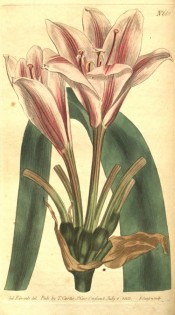Crinum bulbispermum (Burm.f.) Milne-Redh. & Shweick.
Bulbous perennial with slender pointed leaves and, in summer, umbels of 6-12 fragrant, white or pink flowers, flared at the tips and with a central dark red stripe. Flowers rarely pure white. To 60cm. [RHSE, Hortus].
Horticultural & Botanical History
The first botanical description is probably that of Nicolaas Laurens Burman in 1768, Amaryllis bulbisperma [Flora Indica Prodromus Flora Capensis p.9/1768]. William Herbert transferred it to Crinum as Crinum capense in 1820 [BM t.2121/1820] and it was correctly named Crinum bulbispermum by Milne-Redhead and Schweickerdt in 1939 [J. Linn. Soc. Bot. vol.52, p.161/1939].
‘The most hardy of all the Crinums in England and the only one grown generally out of doors.’ [Baker Am.]. Herbert wrote glowingly of Crinum capense: ‘I recommend gentlemen to plant this largely, as a cover for wild ducks on islands, or by the water side. It thrives either on dry land or under water; but entire islands should be planted with it, above the level of the stream. Its blossoming is endless, and it forms a very thick cover about two feet high, the flower-stems rising above. The seedlings should be housed or sheltered until the bulbs are strong enough to plant out. They will grow all the winter if kept very wet, or in a cistern in the stove.’ [GC p.581/1842]. In Curtis's Botanical Magazine William Herbert lists three varieties of Crinum capense, including C. longifolia. [BM t.661/1803]. Crinum capense var. riparia is also figured. [BM t.2688/1826].
The Botanical Register figures Amaryllis longifolia var. longiflora: ‘The plant which has afforded our drawing was received by Mr. Griffin from a garden in Jamaica, without notice of its being or not being indigenous of that Island. Were it native of those parts, we should have had no hesitation in deeming it distinct from the Cape species, under the name of which it is here published. It differs in having a firmer more upright and in no way glaucous foliage, a full third longer flowers, and a bright green furrowless germen. Mr. Griffin thinks that the bulbs of the two are different. But as the distinctions we observed, were such as we conceive to be within the scope of both seminal variation and exotic culture we think it safer to record the plant as a distinguished variety of the present species, than to separate it by a new name, before either the permanence of the differences has been proved, or its original abode ascertained. The dmwing was taken in May last, at Mr. Griffin’s, at South Lambeth, where the plant flowered in the hothouse. There are other specimens of it both in the Cambridge and Liverpool botanic gardens. [BR f.303/1819]. It was also published as A. longifolia var. riparia [BR f.546/1821].
Introduced to Britain in 1752. [JD].
History at Camden Park
Listed in all published catalogues [B.81/1843].
Notes
Published Apr 26, 2009 - 04:43 PM | Last updated Jun 29, 2012 - 01:28 PM
| Family | Amaryllidaceae |
|---|---|
| Category | |
| Region of origin | South Africa |
| Synonyms |
|
| Common Name | Cape lily, Orange River lily |
| Name in the Camden Park Record | Crinum capense
|
| Confidence level | high |


